Student Researchers Collaborate with NASA
By Leigh-Ellen Romm
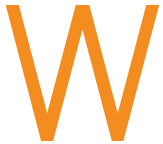
 hile SpaceX, Blue Origin, and Boeing are paying and paving the way for innovative access to space, physicists continue the ancient scholarly work of studying the stars. Here at Austin College, a small group of undergraduates has worked on the NASA-based Transiting Exoplanet Survey Satellite (TESS) project since 2018 to identify exoplanets orbiting the nearest stars outside the solar system. Austin College is a member of the TESS consortium of scientists, universities, and observatories and has contributed significantly to the project.
hile SpaceX, Blue Origin, and Boeing are paying and paving the way for innovative access to space, physicists continue the ancient scholarly work of studying the stars. Here at Austin College, a small group of undergraduates has worked on the NASA-based Transiting Exoplanet Survey Satellite (TESS) project since 2018 to identify exoplanets orbiting the nearest stars outside the solar system. Austin College is a member of the TESS consortium of scientists, universities, and observatories and has contributed significantly to the project.
The satellite, TESS, was launched by NASA and the Massachusetts Institute of Technology on April 18, 2018, aboard a SpaceX Falcon 9 rocket. TESS orbits Earth every 13.7 days. In the first two years, the satellite surveyed 85% of the night sky, first cataloging images of the Southern Hemisphere, then the Northern Hemisphere. Now in the extended-mission phase, the satellite continues in its highly elliptical orbit that is as close as 67,000 miles and as far out as 232,000 miles. TESS can capture wide-shot photographs of the brightest stars but cannot register high-resolution details. That is where Austin College comes in.
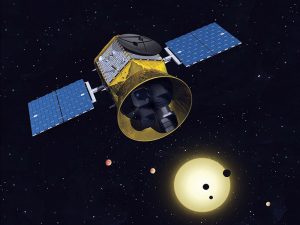
Dr. David Baker, Physics Professor and Director of Adams Observatory, explained, “TESS monitors 200,000 stars. They are relatively near Earth, and they have been chosen because they might be good targets for having planetary systems. If the TESS satellite sees something unusual with a particular star, other observatories around the world will monitor that star more closely … we’re one of those observatories.”
TESS, meet Rose—Austin College’s 24-inch research telescope nicknamed after the “Yellow Rose of Texas.” Housed in the College’s Adams Observatory, painted bright yellow, and weighing 3,000 pounds, this state-of-the-art telescope was installed in the IDEA Center in 2013. Since then, it has opened a window to the universe for students, researchers, faculty, and community members. Rose, which was funded by a generous grant from the John and Patricia Adams Foundation of Bedford, Texas, was tested and qualified to partner with NASA and MIT on this project.
“Years ago, when we were trying to raise money for Adams Observatory, I said, ‘If we do this right, we have the possibility of helping discover new planets.’ We have delivered on that promise,” Baker said.
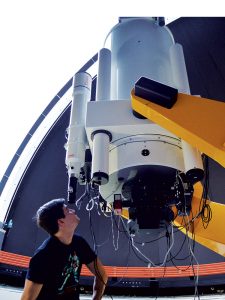
One way scientists discover new exoplanets is by observing transits. A transit happens when an object passes in front of a star. The object, or potential planet, blocks, and therefore dims, some of the star’s light. While closely observing the target star that TESS has identified, Rose’s instrumentation uses photometry to measure the amount of light coming from the target star and from other nearby stars. Baker explains, “We produce what is called a light curve: a plot of star brightness versus time. These measurements are very difficult and require extreme precision. We are trying to detect a small signal and an even smaller amount of ‘noise.’”
“Ultimately, we are looking for a small dip in brightness from the target. If every nearby star’s light curve also shows the dip, then maybe a cloud passed in front of the telescope to block out light from all the stars. That’s why we also look carefully at the nearby ‘comparison’ stars. When there are no dips associated with the comparison stars, perhaps something interesting is happening on the target star,” Baker said.
“Something interesting” would be one or more exoplanets orbiting the target star. Adams Observatory is limited to detecting planets the size of Neptune or larger because Earth’s atmosphere washes out any light variation from a transiting planet smaller than that, Baker explained. Neptune is 30,599 miles wide, four times wider than Earth.
Planet hunting is a relatively new endeavor. The first exoplanet was discovered just 30 years ago in 1992. According to NASA, today more than 4,500 exoplanets have been discovered and confirmed. The relatively young field of exoplanet science has grown up and led to further investigation and discoveries regarding the planets’ makeup, surfaces, sizes, orbits, atmospheres, and more.
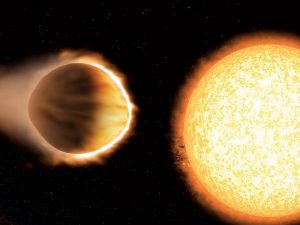
With the Improving Undergraduate Science Education (IUSE) grant from the National Science Foundation, Baker has chosen five students to participate in the TESS project research. They are among the youngest scientists in the world to study, question, corroborate, and present replicable data in this hunt for exoplanets.
The grant provides a stipend for summer researchers and provides opportunity to students who might not otherwise be able to afford the time away from regular summer work.
The first summer researchers, Miles Schnaible ’20, Brett Skinner ’22, and Tanner O’Dwyer ’22, were expecting to be shoulder to shoulder in Adams Observatory pouring over TESS images and generating data. But, COVID protocols during summer 2020 required a socially distanced setup. Very distanced, in fact, as the students searched for planets from their bedrooms at home.
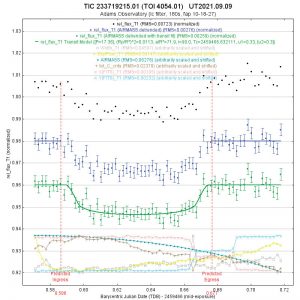
Baker worked on campus to upload the data, which the students downloaded daily to identical computer systems at home. Then they ‘Zoomed.’ Five days a week, they met online from 4 p.m. to midnight to analyze the data and compare their observations. “Because our analysis is done on computer, it was almost as good as if we were all together,” Baker said.
Skinner, completing majors in Engineering Physics and Mathematics with a minor in Accounting, described his home research setup. “I’m sitting in my bedroom with my little, itty-bitty childhood desk from middle school with a wooden chair that barely fits. … My mom is shouting, ‘dinner’s ready’ or ‘take out the trash;’ my brother’s friends are coming over, people coming in and out. I’m trying to focus with all the shenanigans all around me.”
He says his motivation to stay focused and committed was driven not only by the research assignment but also the teamwork aspect. Since they had not been together on campus since March 2020, the connection was special. “Around 3 p.m. every day I would start thinking about the work, and that I get to see my friends and my roommate O’Dwyer, and my professor. Even though it was not in person, that face-to-face interaction was good. I was excited for it, even at home,” he said.
Schnaible, who completed majors in Physics and Theatre, had a similar experience. “We were working afternoons and evenings and stayed on video chats most of the day to keep up communication and teamwork,” Schnaible said. “I have fond memories of seeing everyone’s cats on camera, messing with Zoom backgrounds, and otherwise making the most of our situation. All that to say, we could never have done it without the hard work of Dr. Baker, who was managing the heavy lifting at the observatory all by himself.”
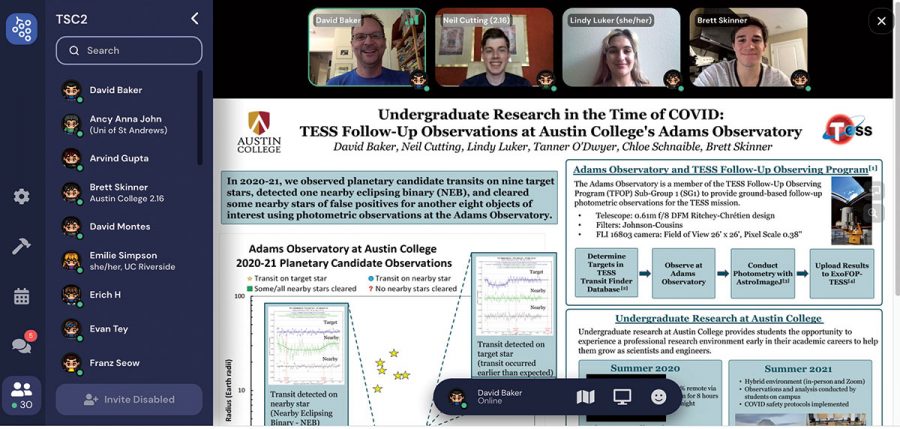
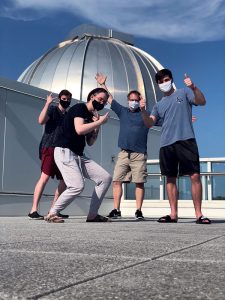
Having worked on earlier research projects with Baker, Schnaible was a valuable leader for the other students. “I spent many semesters and summers working with the telescope, focused on exoplanets and the CCD cameras we used for imaging. I remember what it was like to be new to this research though and struggle to get it all. I showed the students I was working with the same patience I needed when learning this new, challenging material. I offered a different perspective than Dr. Baker in some areas. These skills have helped me practically everywhere I go,” Schnaible said.
As research returned to campus in summer 2021, Skinner returned, but now in the leadership role with a new team of students including Lindy Luker ’23, who is working on majors in both Engineering Physics and Computer Science, and Neil Cutting ’23, completing an Engineering Physics major with a minor in Mathematics. Skinner worked to bring a sense of comfort and “family” to the group. “They didn’t know me before, but now we’re spending so much time together,” he said. “I aimed to create a comfortable environment inside and outside the workplace. We are with each other all day and so close intellectually, so by creating this comfortable environment it’s easier to work critically without stepping on toes.”
Although not hindered as much by COVID, the 2021 team encountered weather conditions that prohibited visibility. On those occasions, they met from 2 p.m. to 10 p.m. to do analysis, study research papers, and practice presentations.
Luker said, “On an observation night, we got there at 8 p.m. and did not leave until 4 a.m.—because the donut shop opens at 4:30. As a team, we were all genuinely friends with each other.” While searching for planets, students found a community to share meals, sunsets, and donut runs before sunrise.
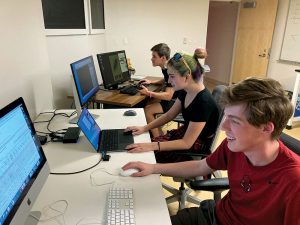
In August, Skinner, Luker, and Cutting attended the virtual TESS Science Conference II, where they presented their research for the hundreds of scientists in attendance. “We were some of the only undergraduates in attendance in the entire conference,” Skinner said. “This billion-dollar operation and here we are—21 and 22 years old—in this giant pool of geniuses. Dr. Baker said he was really proud of us because we were able to stand with these scientists and understand what was going on. They were discussing what has changed since the TESS launch in 2018 and where the mission is going from here. They’re using test data for all kinds of other research as well, not just stars and exoplanets but galaxies and black holes!”
Baker emphasizes to the researchers that all their work must meet a standard of excellence. Skinner summed it up this way, “Since our data are submitted for NASA and all these science teams around the world, there has to be a certain quality standard. Are our results replicable, useful, and produced ethically? The standard of excellence is something we reflect on our own work and ask, ‘Is this something I’m proud of?’”
“Even as an undergraduate, to actually physically use this telescope has been a blessing,” Skinner continued. “This kind of access is something I could have never imagined. This is where I want to be—I’d make this choice again, 10 out of 10 times!”
Undergrads Publish
|
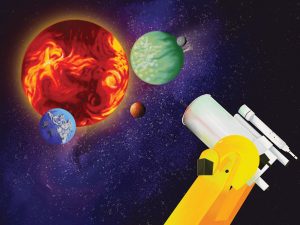 Artist is Inspired by Planet Research
Artist is Inspired by Planet Research
Digital art by Lindy Luker
As a summer researcher on the NASA TESS (Transiting Exoplanet Survey Satellite) project, Lindy Luker ’23 has spent hours analyzing data to assist in the identification of planets in neighboring solar systems. She applies the same intensity to her artistic process.
“I like to do art—in my own time,” she said. “Right now, I’m doing a high-effort art piece with 15 pieces of toned paper. I’m going to fill out every single one with a colored pencil drawing … four are complete, two are in process.” The way Lindy describes the texture and tone of the paper, it’s clear she is completely inspired just by its existence.
After working over the summer and meeting and talking with scientists from all over the world, Lindy says she was excited about art. “So, then I made this art piece. Digital is not my forte, but I thought it would be the best choice for the planet piece. And, then I almost fell right back into the art I traditionally have made.”
Lindy says her time in Adams Observatory has helped her grow as an artist. “Over the summer, I had to have a really strong work ethic to be able to go all day,” she said. “That has changed how I make art. I feel like I can work longer and be more prolific.”
Prolific, yes, and also patient. Moving through the inevitable failures that come with scientific research has helped Lindy move through her art process instead of giving up.
“When I’m in the middle of a piece, I think I’ve become a little more comfortable to go ahead and make a change. Before, I would usually not do that,” she said. “If I see it going into a failure path, instead of letting it just crash-land, I can make the change,” she said.
Lindy is completing a major in Physics with a minor in Computer Science. She is Vice President of the Society of Physics Students, a member of the Improv Troupe and of the Computer Science and Robotics organization, and she is deeply committed to 15 pencil drawings on perfect, toned paper.
|

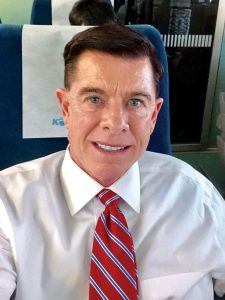 Kelso Working in the Latest Version of Space Travel
Kelso Working in the Latest Version of Space Travel
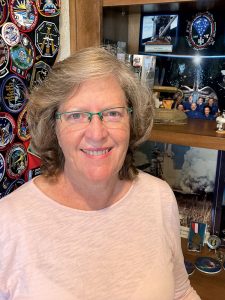 Thomas Encourages Women in STEM
Thomas Encourages Women in STEM